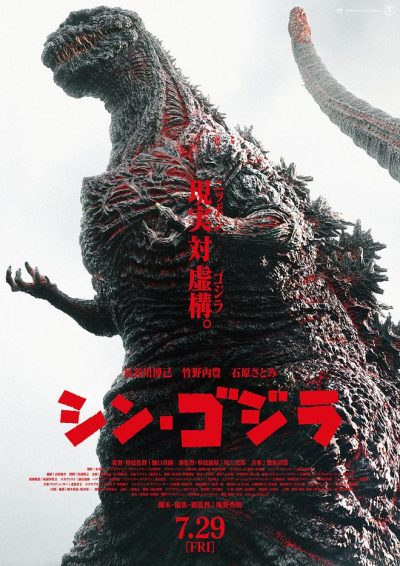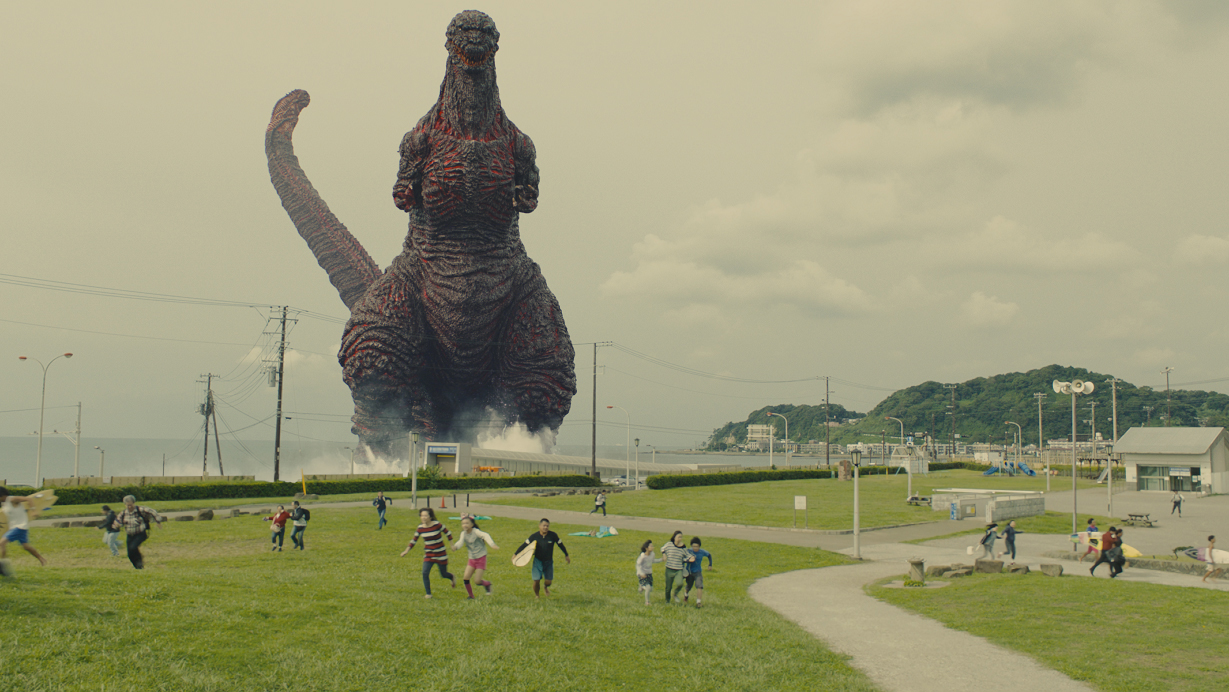
Rating: B-
Dir: Hideaki Anno + Shinji Higuchi
Star: Hiroki Hasegawa, Yutaka Takenouchi, Satomi Ishihara, Kimiko Yo
A Godzilla movie from the creator of Neon Genesis Evangelion might seem like a match made in hell. For at the risk of FilmBlitz Towers being stormed by an enraged mob of mecha fans, I will boldly state that Evangelion is one of the most horribly over-rated anime series of all time, operating largely in an “I’m 14 and this is deep” kinda way, before descending into utter incoherence by its end. Letting him helm the latest reboot – one entirely unconnected to the Hollywood version – seemed like a dubious project, to say the least. I was half-expecting a film where the big G turned out to be a metaphor for Anno’s father or something.
 Fortunately, it’s not. Though it is closer to “Godzilla vs. Bureacracy” than anything else, and is clearly making some pointed observations about the Japanese establishment’s response to disasters like the 2011 earthquake and subsequent tsunami. This actually works better than you’d think, with the pace generally being kept sufficiently brisk that the “political procedural” aspects are engaging. The main problem is the truly awful “Special Envoy for the President of the United States,” Kayoko Ann Patterson (Ishihara), who appears to have learned her English lines phonetically. Could they really not find someone who spoke the language?
Fortunately, it’s not. Though it is closer to “Godzilla vs. Bureacracy” than anything else, and is clearly making some pointed observations about the Japanese establishment’s response to disasters like the 2011 earthquake and subsequent tsunami. This actually works better than you’d think, with the pace generally being kept sufficiently brisk that the “political procedural” aspects are engaging. The main problem is the truly awful “Special Envoy for the President of the United States,” Kayoko Ann Patterson (Ishihara), who appears to have learned her English lines phonetically. Could they really not find someone who spoke the language?
But enough about the humans, because they are strictly of secondary importance. This is a Godzilla movie, and he is what matters. However, it is also a reminder that he has generally tended to be used sparingly in these films, something also true in the Gareth Edwards’ Godzilla. You are intended to be left wanting more. If you felt short-changed by his screen-time in the Hollywood version, this entry won’t make you any happier. Things get off to a shaky start here, design-wise, with the creature’s first incarnation… a bit crap, to put it mildly. It’s so unlike previous versions, I was initially convinced this was actually his opponent – the nameless jobber already in the ring, to use pro wrestling parlance – and was waiting for Godzilla to come roaring out of the ocean, to demolish it in about 10 seconds flat.
Then, it transforms, and you suddenly realize what you’re getting. Much of this is what you’d expect, but there is an interesting twist in that Godzilla is explicitly nuclear-powered. This has been an aspect for as long as he’s been destroying Tokyo, and his origins are profoundly radioactive. That’s true philosophically, as a metaphor for the atomic destruction suffered by Japan in 1945. It’s often specifically so as well, with him portrayed either being a result of nuclear testing or awakened by it. But this may be the first time in a Japanese film Godzilla has been clearly described as a walking reactor.
For example, his dorsal spines are now explained as part of his power station’s coolant system, and that becomes one of the keys to defeating him. The renegade group of rogue scientists, battling the creature after the official system has more or less thrown its hands in the air, believes that by injecting Godzilla with coagulant, this will cause the reactor to go into an emergency shutdown, freezing him. Of course, it’s not as simple as that. Do you know how much coagulant it takes to thicken the blood of a near 400-ft tall creature? And how the hell do you administer it? We can’t even get our cat to take a pill.
 That’s an appropriate comparison, actually. Just as our cat can become an entity composed 99% of claws when it wants, so this incarnation is no longer limited to blowing atomic breath out its mouth. No, this does not mean Godzilla-sized nuclear farts, amusing though that might be [Noboru Iguchi, director of Zombie Ass: The Toilet of the Dead, is likely already in pre-production]. But those fins now are capable of unleashing destruction of their own, effectively turning Godzilla into an atomic porcupine, shooting out laser-like spines that can slice through buildings, stealth bombers, and anything else which gets in his way. Or “Tokyo”, for short.
That’s an appropriate comparison, actually. Just as our cat can become an entity composed 99% of claws when it wants, so this incarnation is no longer limited to blowing atomic breath out its mouth. No, this does not mean Godzilla-sized nuclear farts, amusing though that might be [Noboru Iguchi, director of Zombie Ass: The Toilet of the Dead, is likely already in pre-production]. But those fins now are capable of unleashing destruction of their own, effectively turning Godzilla into an atomic porcupine, shooting out laser-like spines that can slice through buildings, stealth bombers, and anything else which gets in his way. Or “Tokyo”, for short.
And that’s where, inevitably, the film is at its best. Even I would have to admit that Evangelion delivered on the large-scale carnage front, and this does too. I think Higuchi’s background is likely an asset here, with his previous films including their share of disaster porn (Sinking of Japan) and the two-part live-action adaptation of Attack on Titan, which also contains more than trace amounts of monster mayhem. It’s a near-seamless mix of CGI, motion capture and some guy in a rubber suit. Though the last is probably selling Mansai Nomura’s talents as a veteran Shakespearean actor short.
It’s comforting to see there’s apparently room in the cinematic universe for both Western and Eastern versions of Godzilla. After the success of the Edwards’ reboot (in sharp contrast to the previous Emmerich effort). I wondered if that was going to become the canonical monster going forward, with Toho effectively handing the reins over to Legendary Pictures. That would be something of a shame. While very enjoyable, and with a Godzilla that was positively regal and awe-inspiring, it did lose a little “Japan-ness”, becoming somewhat blandly international.
For, let’s face it, Godzilla is Japan, and making him anything else is like making James Bond an American. His origins in an atomic apocalypse may now seem rather quaint and antiquated, in the same way Them! reflects a bygone era of radioactive paranoia. But the Fukushima accident has provided an alternative avenue of contemporary relevance, which Anno and Higuchi have wisely decided to latch onto. There’s more to be done there, and I look forward to the two streams of iconic destruction, running parallel to each other over the coming year.
